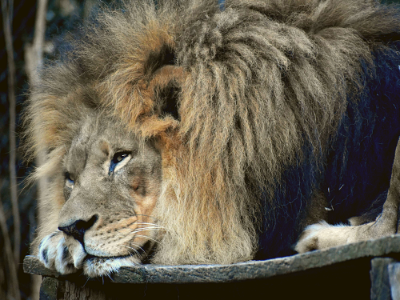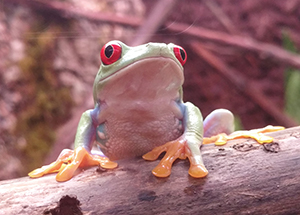Each year in July we celebrate Wild about Wildlife Month, an observance that highlights the conservation and protection of wildlife in their native habitat. The Akron Zoo is committed to protecting endangered species, both at home and around the world, by participating in 21 conservation and recovery projects, in addition to providing science-based education programs to more than 91,000 individuals each year.
However, we can’t do it alone! It takes caring citizens from around the world to take action and make a difference. If you want to help us save species, check out how you can get involved in protecting both local and global wildlife!
Field Conservation
The Akron Zoo’s commitment towards field conservation is reflected in our Conservation Fund program. We support local, regional and global field conservation and conservation based research projects, and you help us with this massive undertaking when you visit the zoo! For every ticket purchase made at the Akron Zoo, one percent of revenue goes toward projects that contribute directly to the long-term survival of species in natural ecosystems and habitats. The Akron Zoo currently supports 21 field conservation projects, including those listed below. Click on each link to learn more!
 Rebuilding the Pride - The ultimate goal of this project is to establish a sustainable way of life for the people and large predators who coexist in the Southern Rift Valley of Africa. Rebuilding the Pride is working to reduce human/lion conflicts and protect lion habitats.
Rebuilding the Pride - The ultimate goal of this project is to establish a sustainable way of life for the people and large predators who coexist in the Southern Rift Valley of Africa. Rebuilding the Pride is working to reduce human/lion conflicts and protect lion habitats. - Red Wolf Coalition - The Red Wolf Coalition focuses its efforts solely on raising awareness about this species and helping to protect it in the wild. The Akron Zoo supports high frequency radio tracking collars for the U.S. Fish and Wildlife Service Red Wolf Recovery Program. Tracking the wolves provides valuable information to help protect them, as well as learn more about this species.
- Snow Leopard Trust - By partnering with the Snow Leopard Trust, the Akron Zoo plays an important role in understanding and protecting endangered snow leopards in the wild. The zoo supports community education initiatives in the snow leopards home range and field monitoring of snow leopards.
- Wildlife SOS - Our support of the conservation organization Wildlife SOS, provides radio collaring and tracking for 10 sloth bears in an area of high conflict between humans and sloth bears in India. The data from this study will provide researchers and forest managers’ with valuable information for minimizing the human/wildlife conflicts.
- White Winged Wood Duck Health Research - In partnership with Hiram College and Sylvan Heights Waterfowl, the Akron Zoo is studying populations of white-winged wood ducks to increase the population’s health and sustainability in zoos.
Citizen Science
Making connections can also happen through citizen science! Citizen science projects provide opportunities for our staff, volunteers and visitors to do real work for the conservation of species. Check out some of the projects we currently are engaged in!
 Christmas Bird Count - Every December, for more than 100 years, people across North America have ventured into the field to count birds. These counts are then compiled into a national database used by conservation scientists to monitor bird populations and make decisions about where they need to focus their efforts. You can be a scientist as well! It doesn’t matter if you are an ornithologist (bird specialist) or a novice. The Audubon Society organizes the count across the U.S. every year, and the zoo works with this group to organize a group in our region.
Christmas Bird Count - Every December, for more than 100 years, people across North America have ventured into the field to count birds. These counts are then compiled into a national database used by conservation scientists to monitor bird populations and make decisions about where they need to focus their efforts. You can be a scientist as well! It doesn’t matter if you are an ornithologist (bird specialist) or a novice. The Audubon Society organizes the count across the U.S. every year, and the zoo works with this group to organize a group in our region.
- FrogWatch USA - Frogs and toads play an important role as indicators of environmental health. As amphibians, they are reliant on both water and land in order to survive, which makes them extremely susceptible to environmental changes. Over the past few decades, frog and toad populations have been declining at a rapid rate; a first sign that there are problems within an ecosystem. FrogWatch USA, initiated by the Association of Zoos and Aquariums, allows members of the community to learn about wetlands, identify frog and toad species, and enter data into a national database to help scientists develop strategies for conservation.
Save Species from Home
You don’t need to partner with a large organization to make a positive change for wildlife; there are several actions you can work into your regular routine to help local and global species:
- Take the Thermostat Challenge - Move your thermostat two degrees warmer in the summer or cooler in the winter to save electricity and money.
- Pledge to be Idle Free - Ask your family, school or business to pledge not to idle their cars for more than ten seconds.
- Make better seafood choices with Seafood Watch - an app that helps guide you toward more sustainable purchases.
- Leave no trace - As we move into summer, many families will be visiting the outdoors for camping, hiking, swimming and more. While in nature, respect wildlife by leaving native plants and animals in their natural habitat. It is also important to clean up after your visit, so that habitats are not damaged by non-native elements, such as human food or harmful plastics.
